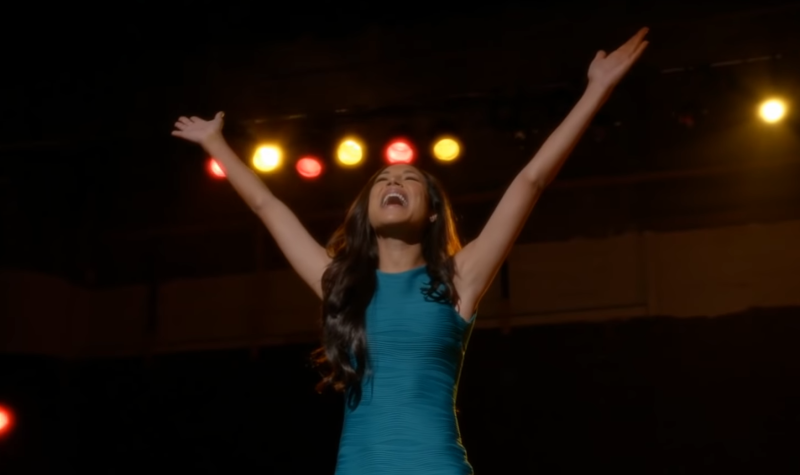When I was 11 and first started watching the 2009 TV show “Glee,” I was an annoying Jewish overachiever who built her entire identity around eventually becoming more successful than my bullies. I was a small-nosed Rachel Berry, however, there was something lurking beneath the surface that rendered me unable to love Glee’s infamous anti-hero. I was attracted to girls.
At the time I hadn’t quite put my finger on it yet, but it was more and more obvious that my desire to be around, look at and be held by girls was not the ubiquitous growing up experience. I had a vague idea of same-sex relationships, but none of it was very clear. I thought if you were a girl who liked girls you had to be boyish and wear alternative fashion — things I wasn’t (doing) at the time. I was a normal girl who happened to think that girls were really pretty and didn’t know what to do with that.
In “Glee,” there was someone else who was struggling with those feelings. Santana Lopez, played by the late Naya Rivera, was introduced in the show as a mean girl equipped with sharp wit and an uncanny ability to perceive one’s deepest insecurities. However, as the show progresses, we find out Santana’s bullying is in part a coping mechanism, meant to help her deflect her own complicated feelings for girls.
Santana was feminine, confident, pretty and she liked girls. In my mind, lesbians were girls who weren’t pretty enough for guys, but finally there was proof that this wasn’t the way it had to be. And while now this kind of TV lesbian is much more common (i.e., Petra from “Jane the Virgin” and Waverly from “Wynnona Earp”), Santana was the first of her kind.
To me that was revolutionary. Because even though my parents were smart enough not to let me watch “The L Word” (2004) at 11, my image of a lesbian was 100 % Shane: a girl with a boyish haircut and trauma. If these traits did not apply, you were probably just a temporary visitor in the lesbian world, bound to soon escape with your male soulmate. In fact, one of the most influential teen dramas of the early 2000s, “The OC” (2003), had shown a bi-curious girl who didn’t stay curious for very long. Marissa, one of the show’s main characters portrayed by Mischa Barton, dates a girl in a grand act of rebellion, only for them to break up a few episodes later because she still has feelings for her ex-boyfriend. Because Marissa was pretty, smart, desirable and had a boy who liked her, heterosexuality was the option she had to choose.
With Santana, it was the opposite — she chose to be with the girl she loved over the boys that would have gladly taken her. “I love girls the way I’m supposed to feel about boys,” Santana tells her Catholic grandmother in the aptly-named season three episode, “I kissed a girl.” It isn’t a bold statement or a guilt ridden admission. It is a fact backed by years of tender love towards someone who she truly cares about — a unique feat for a stereotypical mean girl. It is the conclusion of a long journey to find what was lurking barely beneath the surface.
After this revolutionary declaration, Santana retains her queer identity alongside her full character. She is still a passionate, pampered cheerleader with an unmatched cattiness. The lesbian part of her is mainly reserved for her girlfriend: She does wear pride clothing, looks at every issue from a lesbian perspective and the only people who get to know the intimate details of her sexuality are love interests.
She is the unlikely opposite to the other main gay character in Glee: Kurt Hummel, played by Chris Colfer. His main characteristic throughout the show is being gay, and all the stereotypical flamboyancy that comes with that word. He is primarily written as a gay charcter, while Santana is a character whose primary traits come at odds with her queerness. Santana and Kurt each have a major character arc about accepting their sexuality, and similar arcs about choosing a career in singing, fighting with Rachel Berry and navigating a long-term, long-distance high school relationship. Yet the difference between the two is that while Santana approaches her problems just like any other character on the show, Kurt approaches his problems the way a gay best friend approaches his straight girlfriend’s. Many of his problems are solved by outfabulousing them. He always has quick remarks about his great taste in clothes, Broadway and being “one of the girls.” Kurt is the embodiment of a particular kind of gay man, and there is not a single episode in “Glee” where he escapes from it.
Santana Lopez was an inspiration to my long-skirt, makeup-loving queerness. She inspired my personality-driven queerness (which I sometimes called bisexality, pansexuality or gayness), and allowed me to accept myself at every stage. Santana Lopez taught me that being a girl who loves girls doesn’t mean you have to act like a boy or fulfill any stereotype of mainstream queerness. I am forever grateful for Naya Rivera’s moving nuanced portrayal of her, and hope that despite the actress’ short life, her TV legacy will be recognized forever.
Contact Gil Abend at gilalexandraa ‘at’ gmail.com.
